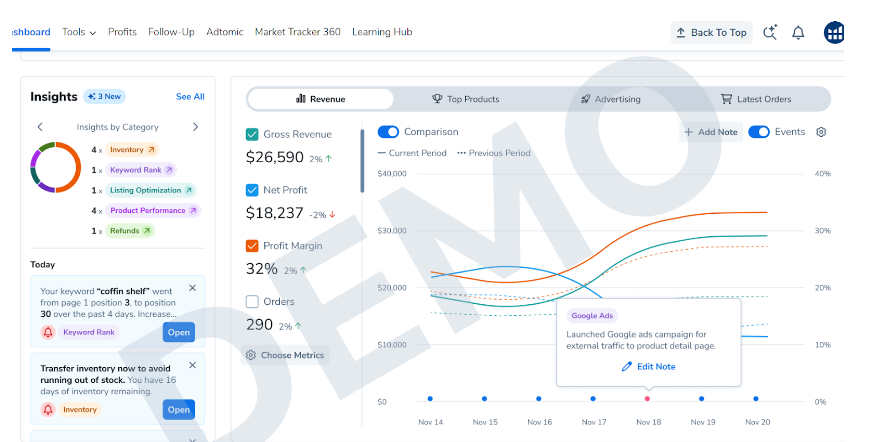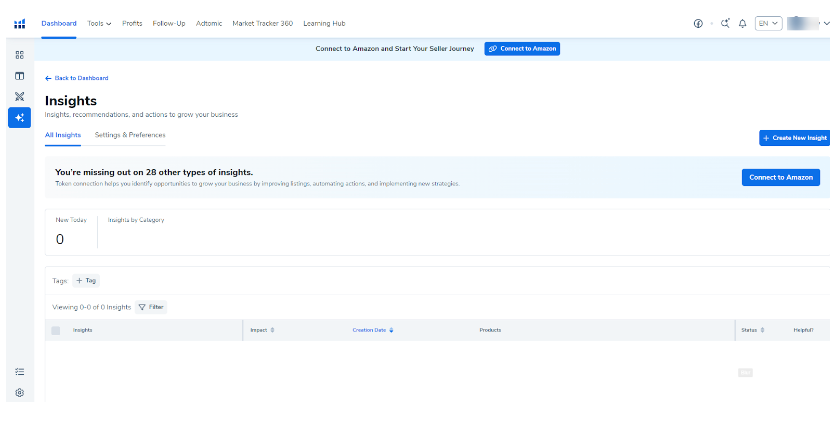Ever wondered how tools like Helium 10 deliver such accurate product and keyword insights for Amazon sellers?
The question many ask is: How Does Helium 10 Get Data that powers its suite of tools? In this guide, we break down exactly how Helium 10 gathers its data — from Amazon’s API to advanced algorithms and user activity.
We’ve listed all the key sources it relies on so you can better understand the accuracy and reliability behind the numbers.
Key Takeaways
- Helium 10 obtains data through a direct connection to Amazon’s API.
- The data reflects actual Amazon activities, ensuring accuracy and relevance.
- Sellers use this data to optimize listings and enhance their sales strategies.
Types Of Data That Helium 10 Collects
Helium 10 is a robust suite of tools designed to assist you, the seller, with invaluable data directly from Amazon’s marketplace. Below is a detailed look at the specific types of data Helium 10 collects to empower your business decisions.

Keywords Data
Helium 10 tracks keyword performance, providing you with insights into search volume, ranking, and trends. This keyword data ensures you know the terms shoppers use to find products like yours.
Niche/Product Data
With Helium 10, you have access to data about particular niches or products, such as sales volume, price history, and market saturation. This niche/product data is crucial for identifying profitable opportunities and assessing market competition.
Competitor Data
Helium 10 offers detailed competitor data, including sales estimates and strategies, inventory levels, and keyword usage, enabling you to benchmark your performance against others.
PPC Data
PPC (Pay-Per-Click) metrics are also gathered by Helium 10, which include impressions, Advertising Cost of Sales (ACoS), and Return on Ad Spend (RoAS). Assess the effectiveness of your ad campaigns with PPC data provided by tools like Adtomic.
Forecast and Demand
Lastly, Helium 10 aids in forecasting demand by analyzing historical sales data and trends to predict future market needs. Make informed inventory decisions using Helium 10’s forecast and demand insights.
Note: If you want to know more about Helium 10? Check our detailed Helium 10 review here.
Data Collection Methods Used By Helium 10
Helium 10 employs a comprehensive data collection approach, ensuring reliable and actionable insights for Amazon sellers. Here’s how they do it:
Amazon API
Helium 10’s primary data source is Amazon’s API, which provides real-time information about sales, prices, inventory levels, and customer behavior. By accessing Amazon’s expansive database, Helium 10 equips you with the actual performance metrics of products on the Amazon marketplace.
Estimations Through Proprietary Algorithms
To supplement direct data, Helium 10 uses proprietary algorithms to estimate sales volume, market trends, and competitive analysis. These estimations are derived from complex models that factor in historical data and current market conditions, offering you a comprehensive view of potential market opportunities.
User Generated Data
Your interactions with Helium 10’s tools can contribute to its data pool. Helium 10 sums this user-generated data to improve its services and provide more personalized insights for your business needs when tracking keywords, measuring product performance, or monitoring market shifts.
Third-Party Partners
In addition to its own tools and user contributions, Helium 10 collaborates with third-party partners to enrich its database. By integrating data from diverse e-commerce platforms and industry analysts, you receive a multi-faceted perspective on market trends, helping you make informed product and strategy decisions.
How Accurate Is Helium 10 Data?
Understanding the accuracy of Helium 10’s data is crucial for making informed business decisions. The platform prides itself on providing valuable insights using a mix of actual Amazon data and algorithmic estimates.
According to an analysis by Jungle Scout, Helium 10 exhibits a 74% accuracy rate for sales volume data, which is a reliable figure for crafting business strategies around product selection and inventory management.
Additionally, Ecomcrew points out that for search volume data, Helium 10 shows a total average deviation of 87% accuracy. These statistics emphasize that while no tool can provide perfect data, Helium 10 offers a high level of precision that can be pivotal in competitive marketplaces like Amazon.
How To Use Helium 10 Data For Ecommerce Growth?
When you leverage Helium 10 data effectively, you can embark on a journey of substantial ecommerce growth. Start by analyzing the product research tools provided by Helium 10 to discover profitable niches and products. The insights gained here will guide you in selecting items that are in demand and have lower competition.

To ensure your listings rise above the competition, use Helium 10’s keyword research tools to find high-demand search terms. Incorporate these keywords into your Amazon listings to improve visibility and drive more traffic. Accurate keyword optimization can result in better search rankings and increased sales.
With Helium 10’s listing optimization tools, you can fine-tune your product descriptions and features. Highlighting the right benefits and solving customer pain points can lead to higher conversion rates. Remember, a focus on clarity and relevance in your listings is key.
The platform’s marketing tools allow you to streamline your marketing efforts, using data to track and optimize your advertising campaigns. This can result in a more efficient ad spend and a higher return on investment.
Make informed decisions by utilizing Helium 10’s analytics tools. They provide you with sales, trend, and inventory data that are crucial for maintaining optimal stock levels and forecasting future sales.
Finally, keep all operations smooth with Helium 10 operations tools, which help manage inventory and minimize losses from stockouts or excess inventory.
By employing these strategies, you can harness Helium 10’s comprehensive data to fuel your ecommerce growth strategy, making data-driven decisions to bolster your online presence and profitability.
More Helium 10 Guide:
- How To Use Helium 10
- Helium 10 Chrome Extension
- Helium 10 Adtomic Tool
- Helium 10 Academy
- Helium 10 Mobile App
Conclusion: Helium 10 Gets Its Data From Amazon API!
Helium 10 is a great tool for selling on Amazon. It gets its information right from Amazon, so you know it’s true. Helium 10 uses this info to give you tools that help you see how much money you’re making and how well your products are doing. With Amazon API, Helium 10 ensures that the data you receive is up-to-date and reflective of actual Amazon data.
Remember, with data playing a crucial role in the competitive Amazon marketplace, choosing a tool like Helium 10 can be pivotal in maintaining an edge. Educate yourself on these tools, perhaps even through Helium 10’s own Freedom Ticket course, to maximize the effectiveness of the data at your disposal.
- Shopify 3 Months For $1 (DEC 2025) – 90 Days Trial - October 3, 2025
- Helium 10 Free Trial (2025) — Access Premium Features - September 4, 2025
- Jungle Scout Free Trial (2025) — Get 7 Days Access Now - September 4, 2025

